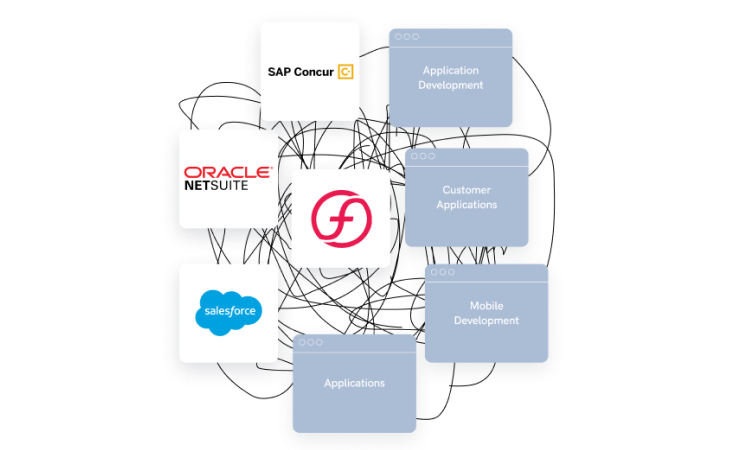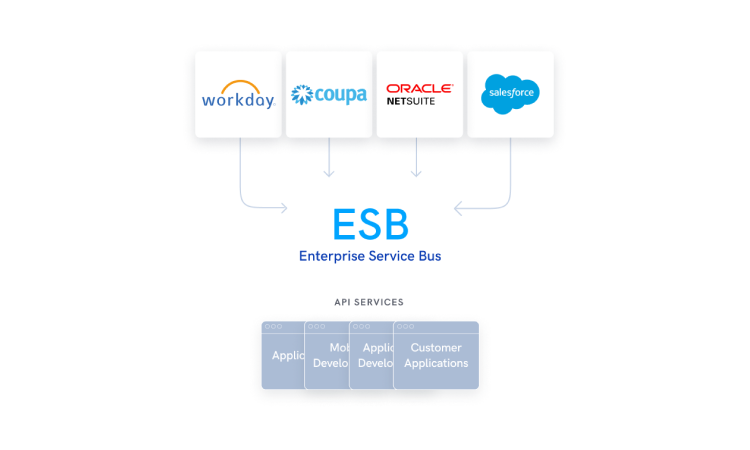Supply Chain Management & Data Integration: How CIOs Can Boost Clarity & Efficiency Through Digital Transformation
Executive Summary: As the CIO of a manufacturing company, how can you champion turning data into information, and information into insight? Learn the 3 digital transformation strategies CIOs can use to boost data clarity and efficiency around Supply Chain Management.
Article
9 min read

“The goal is to turn data into information, and information into insight.”
– Carly Fiorina, former executive, president, and chair of Hewlett-Packard Co.
As the CIO (Chief Information Officer) of a manufacturing company, how can you champion turning data into information, and information into insight?
That's a major challenge. Especially when it comes to Supply Chain Management (SCM), where:
- The speed of the business and the need to adjust has exploded
- There are more distribution channels and suppliers than ever
- The number of apps, data nodes and systems that companies use has grown dramatically
- Those apps, nodes and systems don't talk to each other very well out of the box
If those factors make you feel the challenge is too much to handle, then you're on the right track.
Why?
Because turning data into information, and information into insight is too much to handle...
...when approached with yesterday's solutions: aging tech, paper-based processes, manual scripts, non-scaling workflows, and short-term "fixes" at the level of individual apps and business divisions.
But it's a different story when CIOs:
- Approach their Supply Chain Management challenges at the enterprise level
- Boost efficiency through modern data integration and automation
- Leverage scalable tech solutions, like API-connectivity through cloud-based iPaaS (Integration Platform as a Service) platforms
In other words, today's CIOs need to embrace digital transformation because only modern technology can give our companies what we need to gain true data clarity and efficiency:
- Speed
- Agility
- Flexibility
- Accuracy
- Re-usable assets
- Reduced operational costs
- Single source of truth (SSOT) for data
"You can only use what you have to create the best outcome if your data is integrated and you're using it all to its full potential."
– Western Forest Products (Launchpad client)
Let's look at 3 digital transformation strategies CIOs can use to boost data clarity and efficiency around Supply Chain Management.
STRATEGY #1: ENTERPRISE-LEVEL APPROACH
We mentioned one of yesterday's outmoded solutions is short-term "fixes" at the level of individual apps and business divisions.
It's an all-too-easy trap for CIOs to fall into.
Especially when facing:
- Siloed business workflows and departments
- Overwhelming amounts of information
- Fragmented data nodes
- The urgent demand to put out endless "small fires"
But small and isolated thinking doesn't work when it comes to efficient Supply Chain Management (SCM).
Just look at any manufacturing company's business model and you quickly see how SCM encompasses most of the typical workflows and systems.

It's not uncommon for a company's Supply Chain Management umbrella to cover:
- Sourcing/Procurement
- Production
- Inventory (internal and vendors/suppliers)
- Marketing
- Sales
- Shipping/Distribution/Logistics
- Returns
- Information systems
- And more
That wide scope makes SCM a very large undertaking at the best of times.
But it also means SCM represents many opportunities to realize improvements in efficiency and data management that can significantly move the needle in your organization.
"With so many places along the supply chain that can add value through efficiencies or lose value through increased expenses, proper SCM can increase revenues, decrease costs, and impact a company's bottom line."
– Investopedia
That's why CIOs need to pause, step back, and insist on implementing a proactive enterprise-level approach rather than a reactive fix-it-as-you-go approach...all while keeping the business running.
That was the challenge facing Launchpad's multi-million-dollar manufacturing client, Western Forest Products (WFP).
"We wanted to modernize and harmonize our approach to data architecture," explained WFP's Enterprise Architect, Stephen Thorne, "but without the transition causing any disruption to our business."
WFP recognized they needed to adopt an enterprise-level integration of their data and systems to increase their data insights and efficiency across the entire business.
Did it take more up-front effort?
Of course. But only in the same way that insisting on having a blueprint drafted before starting to build a house takes more up-front effort than just starting to nail boards together here and there.
Did the enterprise-level plan have to be rolled out all at once?
No. While it's invaluable to develop a business-wide digital transformation plan, it's also best to identify your most costly bottleneck and only start your implementation there.
That's what WFP did.
- Their biggest bottleneck: An unreliable integration with a major US border customs broker that involved paper, faxes and manual data manipulation.
- The solution: The Launchpad team worked directly with the border customs broker to integrate and automate their system with WFP's.
Starting with a smaller project like that makes the process manageable instead of trying to overhaul all your Supply Chain Management business workflows, data nodes, EDI (electronic data interchange) configurations, and so on, all at once.
Since SCM is such a large target, CIOs need to step back to gain that enterprise-level plan, then progressively implement a more integrated and holistic system going forward.
Regardless of the unique enterprise-level plan and initial small implementation project you decide on, your execution process will necessarily require the remaining 2 digital transformation strategies.
STRATEGY #2: MODERN DATA INTEGRATION & AUTOMATION
When it comes to tying together all your data-related flows and systems, nothing does it better, faster, more reliably, and with less cost than today's cutting-edge integration and automation technologies.
In contrast:
- Manual tasks are too slow and prone to errors
- Spreadsheets are too disconnected and cumbersome
- Isolated apps are recipes for introducing data inconsistencies
Unfortunately, most businesses today are saddled with some version of that reality.
According to Forbes:

Whether you're working with custom legacy apps, internally-built apps, or today’s leading ERPs, CRMs and enterprise solutions, you can transform your organization by leveraging modern workflow connection solutions.
It can be hard to imagine just how significant that transformation can be:
- From Tedious to Automated
- You can leave the data management to the machines since they’re better at it anyway. That frees up your team to do truly profitable work.
- From Fragmented to Integrated
- With all your workflow apps connected and automated, you can see the big picture instead of getting lost in isolated and overwhelming data points.
- From Unmanageable to Efficient
- Forget trying to patch together apps through manual tasks and data copying. Your modern data integration and automation solution does it for you instead, with greater accuracy, speed and cost effectiveness.
When we bring the focus back to Supply Chain Management, data integration and automation solutions give CIOs tremendous competitive advantages, such as:
- Efficient Sourcing through real-time integration with vendor systems
- Simplified Purchasing through contact tracking and alerts
- Effective Contracts Management through automated maintenance and renewal
- Accurate Invoicing through access to up-to-date pricing and terms
- Improved Deliveries through precision timing and accuracy 24/7/365
- Tighter Partnerships through integrations with third-party systems
- Enterprise-Level Decision Making through data clarity and rich insights
That's the power of cutting-edge technologies to boost clarity and efficiency across Supply Chain Management.
The final digital transformation strategy looks at the specific best-in-class integration and automation technology available today.
STRATEGY #3: CLOUD-BASED IPAAS
iPaaS (Integration Platform as a Service) is a tech platform that a third-party company usually provides through the cloud to help CIOs and companies integrate and automate their apps and data.
iPaaS also helps you create efficiency and scalability in a way that only digital technology can.
The best way to understand the power and cost-effectiveness of iPaaS is through a quick case study.
One of our Fortune 500 clients – CRM giant Salesforce – was facing a data integration nightmare.
They had 54 data nodes and were headed toward building an unwieldy 1400 point-to-point connections.
Direct connections between data nodes are very inefficient, to say the least
To get just a glimpse of what that would look like, check out the illustration below. This is what's called a point-to-point (P2P) network.

In a P2P network, all your process flows are direct between two nodes. There's no logic layer between the nodes. There's no intermediate transformation of data.
Direct connections between data nodes are very inefficient, to say the least.
But that's the way many businesses try to tackle integrating and automating their data and apps. One dedicated connection at a time.
The alternative is how we do iPaaS at Launchpad: through a modern Enterprise Service Bus (ESB) architecture.
With an ESB model, you gain the advantage of having connectivity from any and all of your apps through a central intermediate ESB layer.
That's exactly how we helped our client. Instead of that spaghetti-like mess seen above, they ended up with something elegant and efficient like what's seen below.

"Launchpad has the right mix of experience, skill, and leadership to bring any team to the next level. Do it and don't look back."
– Salesforce Business Technology Team
With an iPaaS ESB model, when any of your apps need access to a piece of data, you don't have to create (or recreate) another data connection. Instead, everything gets routed through your ESB layer.
That means you have superior data access and management but with less connections, which increases your efficiency and lowers your operating and development costs.
You can even leverage existing connectors, such as the 400+ pre-built connectors available through Lauchpad's PaasportTM Integration Platform.
Increasing your efficiency through less connections is only one of many reasons why iPaaS is the best technology today for data integration and automation.
Learn more about iPaaS from our blog article, 4 Reasons to Use iPaaS for Data Integration.
Better yet, with Launchpad you don't have to try to figure out yet another technology. Our team of experts will plan, configure and manage your enterprise-grade integration from start to finish on our PaasportTM iPaaS platform.
“Launchpad’s team guided our transformation project to success through their expertise and knowledge of industry best practices."
– SAFE SOFTWARE
SUMMARY & NEXT STEPS
Progressive CIOs can boost data clarity and efficiency through 3 digital transformation strategies:
- Approaching their Supply Chain Management challenges at the enterprise level
- Relying on the power of modern data integration and automation
- Leveraging a scalable cloud-based iPaaS platform
We help companies with those strategies every day. Our specialty is providing worry-free integrations that are fully managed and hosted so you can free up your team to focus on what they're best at.
About Launchpad
We Integrate Your Apps. You Scale Freely.
We provide next-generation integration platform capabilities and custom integration services for connecting and managing enterprise automation and data integration.
Get your integration started – contact us today.
1.800.326.0188 | info@golaunchpad.io
Try Launchpad risk-free
Transforming your integrations is easier than you think. Get started quickly with us.
- ©Launchpad 2024
- Privacy Policy
- Support